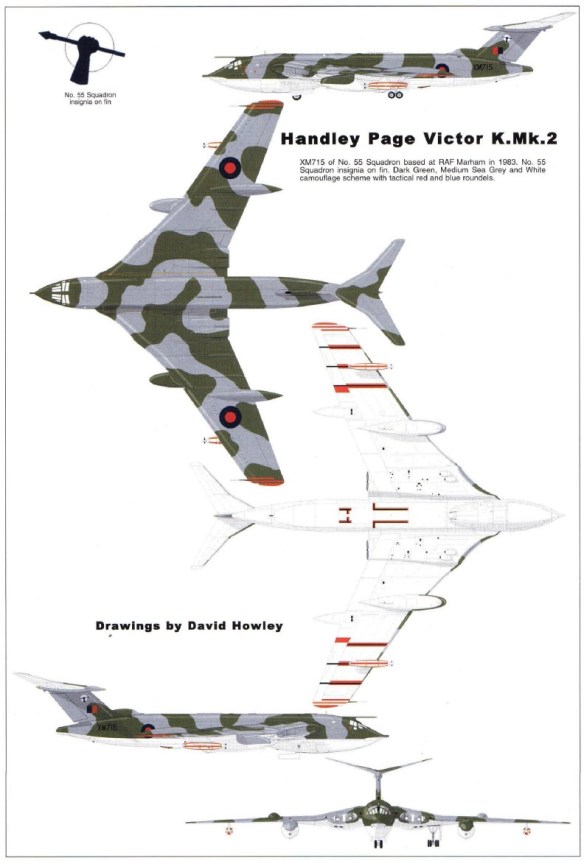The graceful Victor was the last of Britain’s famous V-bombers. Technologically advanced when conceived, it was quickly outdated and performed more useful service in tanker and reconnaissance roles.
After World War II, and anticipating the technological trends of the day, Britain determined to maintain a strategic bombing force that would be jet-powered and carry atomic weapons. Specification B.35/46 was thus issued in 1946 to secure such aircraft, and Handley Page responded with a unique design quite different from its competitor, the Avro Vulcan. The Victor was the third of Britain’s V bombers to fly and despite being less well known than the Vulcan it was arguably the best of the three. The Victor was faster, higher flying and capable of carrying a heavier bombload than both the Valiant and Vulcan. First flown in 1952, the Victor was a graceful, high-wing monoplane of rather sophisticated lines. The wing was crescent-shaped with decreasing degrees of sweep toward the tips. This arrangement allowed a constant critical Mach number over the wing for fast speed and high-altitude performance. The front fuselage was also unusual in that the front cabin was slightly podded and drooping while the rear was crowned by a high “T” tail, also of crescent design. The object of the Victor’s construction was to enable higher speed and altitude than contemporary fighters. However, by the time it debuted in 1958, the Russians had perfected Mach 2 fighters and surface-to-air missiles. Thus, the first-model Victor, the B Mk 1, was obsolete as a nuclear strike craft from the onset. By 1964 several had been converted into K Mk 1 tankers to replace the aging and ailing Vickers Valiant.
The 50 initial Victor B.1’s entered service in 1958 and these were powered by four Sapphire turbojets. From 1960 24 were fitted with additional ECM gear to become B.1A’s. The Victor B.2 entered service from 1962 and featured more powerful Rolls-Royce Conway 200 turbofans. Thirty four were built and most were later upgraded to B.2R standard with even more powerful Conway 201’s. Nine B.2’s were converted to B(SR).2 standard with cameras and SLAR for the strategic reconnaissance mission. By 1968 the B.2R had been withdrawn from service and the B(SR).2’s had followed by 1975.
Thirty-one B.1/B.1A’s were converted to K.1/K.1A tankers from 1965 and from 1972 they were joined by 24 converted B.2s and SR’s as K.2’s. The K.2’s saw extensive service in the Falklands and the 1991 Gulf War before being finally retired in 1993.
The final version of the Victor, the B Mk 2, was redesigned as a low-altitude bomber and, hence, was fitted with a stronger, redesigned wing. It also possessed trailing-edge fairings to improve low-altitude maneuvering. With manned bombers being supplanted by guided missiles, however, it was decided to convert these aircraft into tankers as well. Several were also subsequently modified into SR Mk 2 strategic reconnaissance craft capable of photographing the entire Mediterranean in only seven hours. Four such craft could also cover the entire North Sea region in only six hours! These graceful machines were finally withdrawn from service in 1994.
Variants
Ventral plan of a Victor K Mk.2
HP.80
Prototype, two aircraft built.
Victor B.1
Strategic bomber aircraft, 50 built.
Victor B.1A
Strategic bomber aircraft, B.1 updated with Red Steer tail warning radar and ECM suite, 24 converted.
Victor B.1A (K.2P)
2 point in-flight refuelling tanker retaining bomber capability, six converted.
Victor BK.1
3 point in-flight refuelling tanker (renamed K.1 after bombing capability removed), 11 converted.
Victor BK.1A
3 point in-flight refuelling tanker (renamed K.1A as for K.1), 14 converted.
Victor B.2
Strategic bomber aircraft, 34 built.
Victor B.2RS
Blue Steel-capable aircraft with RCo.17 Conway 201 engines, 21 converted.
Victor B(SR).2
Strategic reconnaissance aircraft, nine converted.
Victor K.2
In-flight refuelling tanker. 24 converted from B.2 and B(SR).2.
HP.96
Proposed military transport of 1950 with new fuselage carrying 85 troops. Unbuilt.
HP.97
1950 civil airliner project. Not built.
HP.98
Proposed pathfinder version with remotely operated tail guns and powered by Conway engines. Rejected in favour of Valiant B.2.
HP.101
Proposed military transport version of HP.97. Not built.
HP.104
Proposed “Phase 3” bomber of 1955 powered by Bristol Olympus or Sapphire engines. Not built.
HP.111
1958 project for military or civil transport, powered by four Conway engines. Capacity for 200 troops in military version or 145 passengers in airliner in a double-decker fuselage.
HP.114
Proposed “Phase 6” bomber designed for standing patrols carrying two or four GAM-87 Skybolt ballistic missiles.
HP.123
Proposed military tactical transport based on HP.111 and fitted with blown flaps. Rejected in favour of Armstrong Whitworth AW.681.
General Specifications
Crew Five (Pilot, Co-pilot, Air Electronics Officer, Nav-Radar Operator and Nav-Plotter)
Powerplant
Number of Engines Four
Powerplant type Rolls Royce Conway RCo17 Mk 201 non-afterburning turbofan
Max Power Rating 9,344kg
Dimensions
Length 35.03m (114ft 11in)
Height 8.57m (28ft 1.5in)
Wingspan 34.44m (113ft)
Wing Area 204.38m2 (2,200sq ft)
Weights
Empty Weight 51,936kg (114,500lb)
Max Take-off Weight 107,955kg (238,000lb)
Internal fuel load 45,359kg (100,000lb)
External Fuel Load 12,247kg (27,000lb)
Landing Gear
Type Retractable tricycle type with eight-wheel main units and a twin-wheel nose unit
Wheel Track 10.06m (33ft)
Performance
Maximum Range 3997nm (7403km; 4,600mi)
